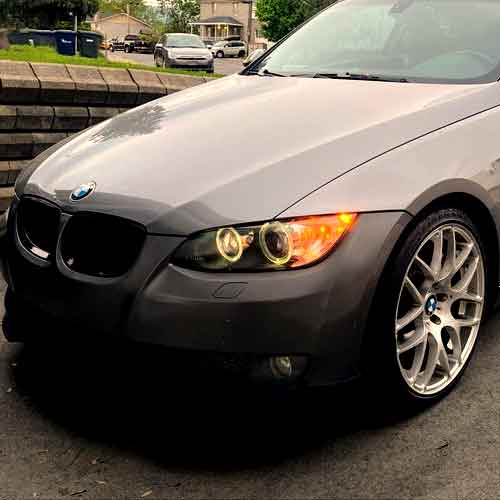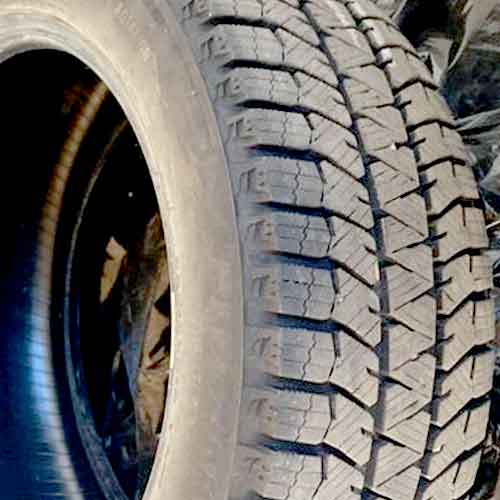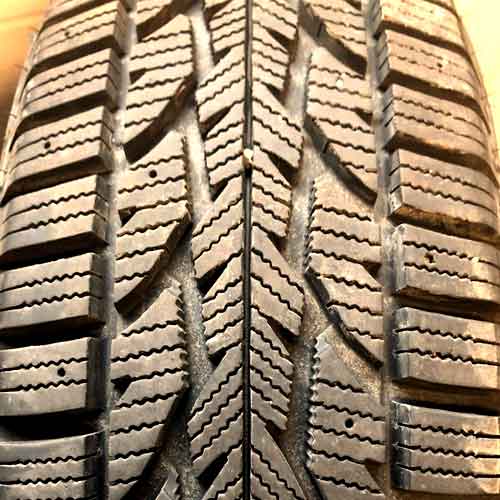The face-off between the Bridgestone Blizzak WS90 and the Firestone Winterforce 2 turns the spotlight on two industry heavyweights. The Blizzak WS90’s optimized contact footprint competes with X-Ice Snow’s Flex-Ice 2.0 compound. Which will take the crown?

Table of Contents
Tire Sizes
The Bridgestone Blizzak WS90 comes in 52 total sizes in 15 to 19 inches (wheels) with following specs.
- Speed ratings: T or H.
- Load ratings: SL or XL.
- Tread depth: 11 or 12/32″.
- Weight: 17 to 29 lbs.
Review this tire in greater detail: https://snowytires.com/bridgestone-blizzak-ws90-review/
On the other side, the Firestone Winterforce 2 comes in 14 to 18″ with following.
- Speed ratings: S on all.
- Load ratings: SL and XL.
- Tread depth: 12/32″ on all.
- Weight: 15 to 35 lbs.
Review this tire in greater detail: https://snowytires.com/firestone-winterforce-2-review/
Tread Appearance
The Bridgestone Blizzak WS90 stands out because of its strong and detailed tire tread design. Let’s explore these details together.

The tread consists of three primary sections, known as ribs…Let’s dissect them individually.
Starting with the shoulders, or should I say, outer ribs, here the lugs are abundantly filled with biters.
The presence of lateral notches facing the center, coupled with longitudinal slits you see in the central area of these lugs, provide exceptional traction capabilities.
Additionally, these shoulder blocks showcase zigzag slits running parallel to the tire’s edges. And yes, mirroring typical winter tire traits, these blocks are densely populated with siping.
In the middle, the ribs is made continuous running.
It features small lateral slits which progressively widen towards the edges, and move towards the V-shaped (notches) opening.
These V shaped biters are facing both sides, laterally, by the way.
Lastly, this central rib doesn’t fall short in terms of siping either, so you get ton of these full depth interlocking, and 3D sipes.
On the other hand, Firestone Winterforce 2 also features a directional pattern.

The tread has three sections, that look like columns of blocks, (their technical term is rib).
So these ribs create 4 longitudinal channels as you can see.
The central-most rib don’t form any proper blocks, though its very biting. It looks a pattern of leaves on a vine.
You get to sharp notches here, along with small toothed edges, and of course a lot of siping (like all other winter tires).
The surrounding ribs are more aggressive, and besides having all those features of notches and siping, they get to have a more open structure, allowing for interconnected groove formations.
Though the shoulder lugs are very blocky/squared-off.
So they although carry stud holes and wave-like sipes like other blocks, they don’t provide as many biters.
Wet Traction
Wet traction is primarily determined by two factors: grip, and resistance to aqua or hydroplaning, and we have some mixed results.
In case of grip, the Blizzak WS90 takes the lead with its multi angled sipes, and a mixture of both rectilinear and interlocking patterns.
These basically point in multiple directions and suck up the water particles, clearing path for the rest of the biters/tread rubber to grip in.
(That’s how sipes work BTW, the create vacuum, and suck water in).
On the other hand, the Firestone Winterforce 2 is equipped with only laterally-oriented siping and missing with rectilinear pattern of those slits.
So you do not get as much of a grip, though the tire does slightly better when it comes to aquaplaning (which is a term used to describe, when a tire starts to float over water).
During testing, the tire demonstrated marginally higher speeds in both curved and straight aquaplaning tests, and this is because it’s wider groove channel out water much faster compared to its counterpart.
So overall Bridgestone Blizzak WS90 does better in grip, while the Firestone Winterforce leads the way, when it comes to hydro or aquaplaning resistance.
Snow Performance
In varying snowy conditions, both tires deliver competitive performance, demonstrating their prowess in handling these wintry challenges. Despite this, the Firestone Winterforce 2 carves out a slight edge, particularly when negotiating slightly fluffy snow terrain.
And a closer look at its tread pattern elucidates why.
Even though it boasts a directional tread pattern, its lugs present a more open design, enabling enhanced snow-to-snow contact. The loosely packed snow is effortlessly scooped up by the tire’s interlocking grooves and snow-trapping recesses.
Once captured, the snow creates a snowy interface between the tire and the ground, offering superior traction. This is owing to the fact that snow adheres more effectively to other snowflakes as opposed to rubber.
In contrast, the Bridgestone Blizzak WS90 appears more enclosed, establishing a continuous running rib at its core and lacking the interlocking groove configuration.
Consequently, its tread doesn’t pick up as much snow, falling a bit short of its competitor.
So you can easily say that on Ice, the Blizzak WS90 shines more compared to its counterpart.
Tread Life
The lifespan of a tire’s tread is largely influenced by its rolling resistance. In this respect, the Blizzak surpasses its rival.
The reduced weight of the tire lessens the pressure exerted by its blocks on the surface, leading to decreased friction and, consequently, a slower overall rate of rubber degradation.
Conversely, the Firestone Winterforce 2 is not only heavier but also concentrates this extra weight on a smaller rubber surface due to its wider tread voids.
This causes each lug to bear a greater amount of weight, contributing to quicker tread wear and, ultimately, reducing its overall lifespan.
However, it’s important to note that the disparity in performance between the two tires isn’t substantial, explaining the absence of warranties from both brands.
So the Tread Life is seen better on Bridgestone WS90.
Ice Performance
Transitioning to icy conditions, the Bridgestone Blizzak WS90 rises to prominence, demonstrating a more favorable average braking distance compared to the Firestone Winterforce 2. Impressively, it halted an average of whopping 15 feet sooner in tests.
Similarly, during acceleration tests, the Blizzak hit the 40 mph mark a full 1.5 seconds quicker from a standstill.
So, what’s the secret behind this impressive performance? The answer lies in the Blizzak’s complex tread biter arrangement.
Its central rib boasts slanted cuts of varying widths, dual-directional V-shaped notches, and a rich supply of sipes, all contributing to its superior grip on icy terrain.
Importantly, these biters also feature dual angles, which further enhance grip and contribute to the tire’s efficient braking performance.
As it pertains to handling, where the shoulder lugs play a crucial role, the Blizzak again shines with biters oriented in both lateral and longitudinal directions, assuring superior grip from every angle. Furthermore, the sipes here also possess two distinct angles, mirroring the design in the central lugs.
In contrast, the Firestone Winterforce 2 takes a backseat due to its larger tread voids and much wider notches.
When it comes to braking effectively, the central tread area is pivotal, and here, the Winterforce 2, with its wider lateral tread voids, struggles to establish a solid grip on compact ice.
Additionally, the absence of multi-angled siping doesn’t do the tire any favors. See how all of those sipes are laterally arranged on the tire’s tread (in the appearance section above).
So together, you get lacing performance of the Firestone’s tire compared to Blizzak.
Comfort Levels
The comfort derived from a tire hinges on elements such as road noise and vibration absorption, all of which can be swayed by the tire’s design, materials incorporated, tread pattern, and sidewall structure.
Let’s delve into each aspect individually.
o noise predominantly arises from air particles colliding with the tread walls. And so the Bridgestone Blizzak WS90 with its comparatively closed up tread voids, offers slightly superior performance.
In contrast, the Firestone Winterforce 2 presents marginally superior performance in terms of vibration damping, offering better cushioning over road irregularities.
So here, overall, both tires essentially balance each other out in terms of comfort, resulting in a draw.
Fuel Economy
Fuel consumption is influenced by the tire’s adhesion to the road and its overall structural weight.
Having said that, the Blizzak WS90 with its lighter weight comes out better.
With that its lugs aren’t pressurized as much against the road, resulting in lower rolling resistance values.
Moreover, you also get a more streamlined central rib on the tire compared to its counterpart. This allows for a smoother rolling of the tire.
On the contrary the Firestone Winterforce 2 lacks with its considerable weight, which escalates its overall rolling resistance.
With greater weight, basically, lugs bend a lot as the tire corners, for example. This generates heat and wastes energy that could have been used in to the rolling of the tire.
So overall, the Firestone’s tire lacks in providing as much fuel economy as the Blizzak.
Summing Up
Ultimately, the decision hinges on these considerations:
The Firestone Winterforce 2 stands out as the preferred choice for fluffy snow terrains, but when it comes to packed snow and icy conditions, the Blizzak WS90 displays superior performance, demonstrated by shorter braking distances and handling times.
On tarred surfaces, the Blizzak WS90 again takes the lead in both wet and dry circumstances, while the Firestone Winterforce 2 tire holds an edge when it comes to hydroplaning resistance.
Beyond these factors, both tires deliver commendable ride comfort: the Blizzak provides a quieter journey, whereas its counterpart excels in shock absorption over bumps.